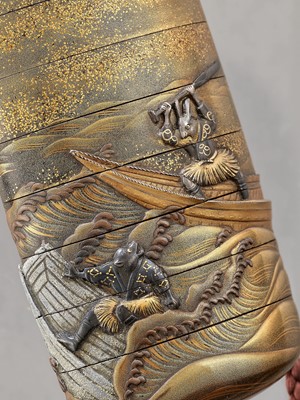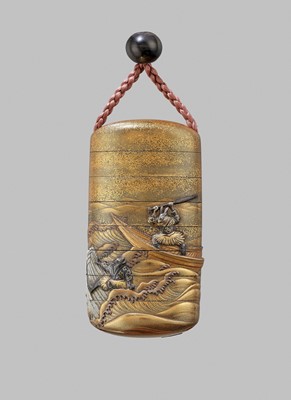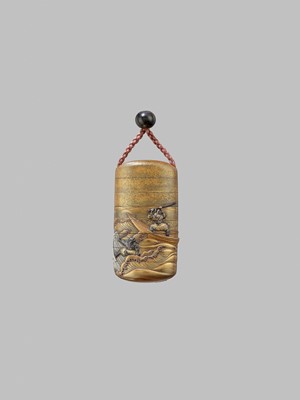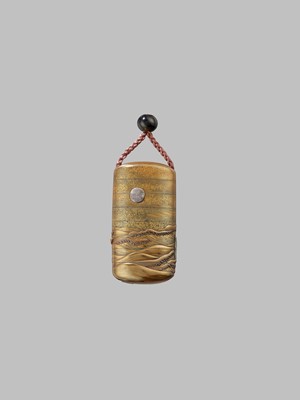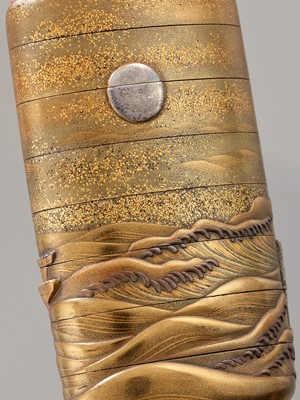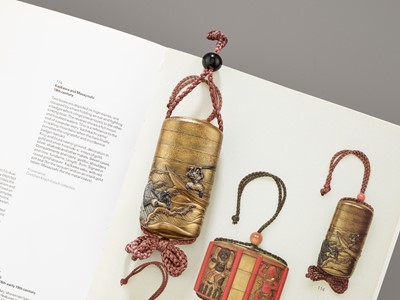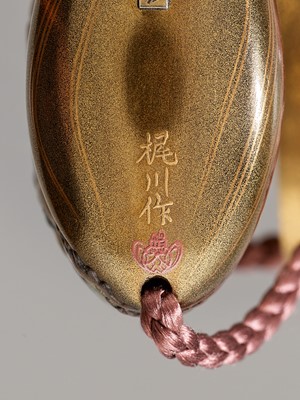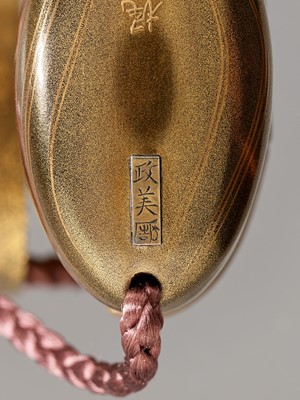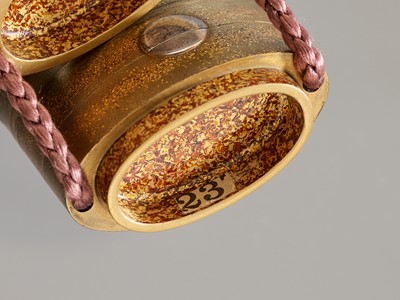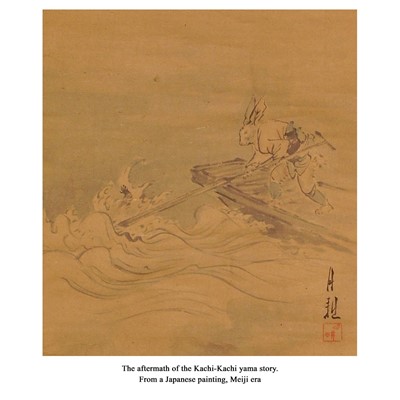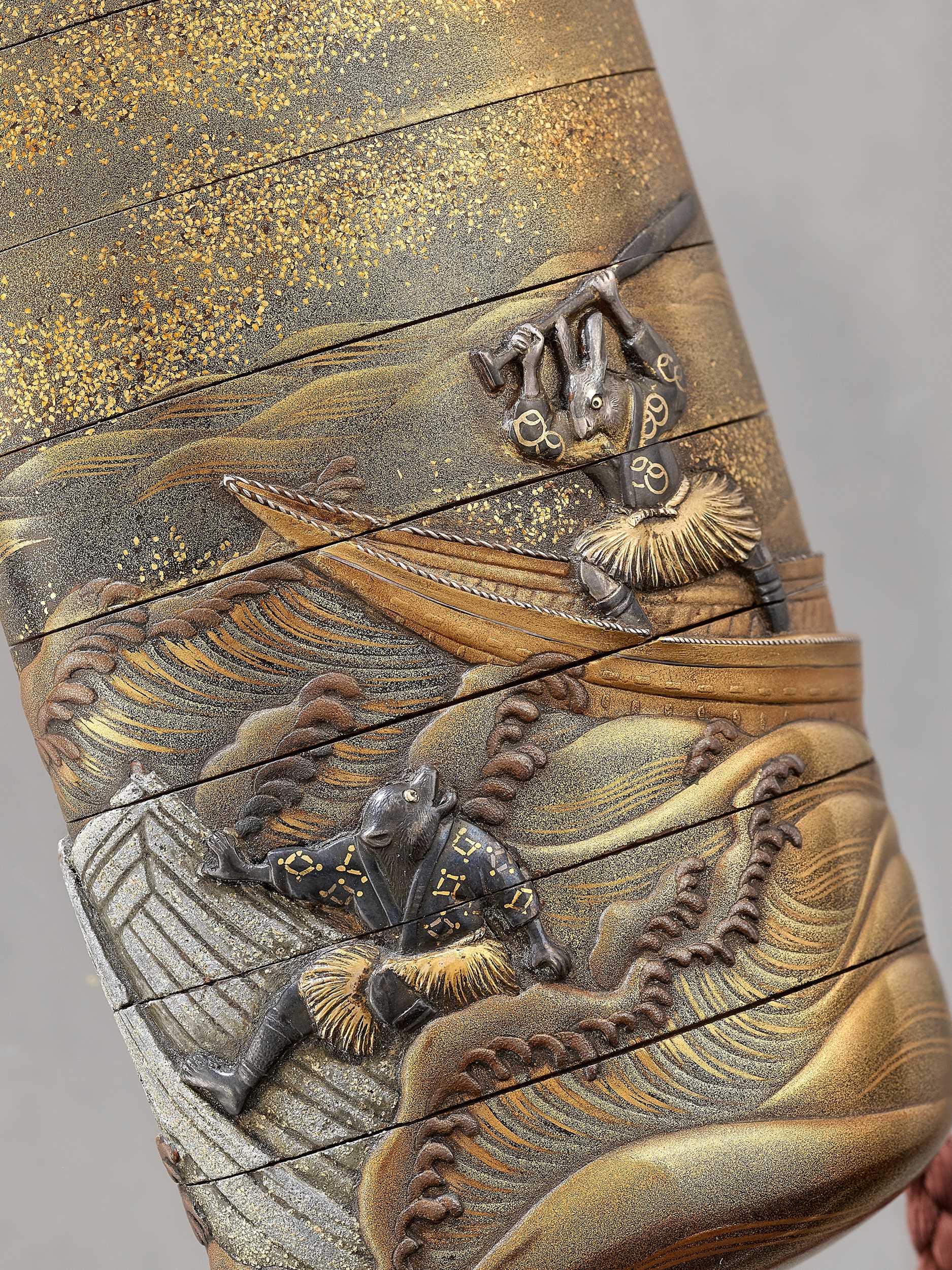27th Jan, 2022 10:00
Asian Art Discoveries
620
KAJIKAWA AND MASAYOSHI: A SUPERB AND VERY RARE GOLD LACQUER AND METAL-INLAID SEVEN-CASE INRO DEPICTING THE KACHI-KACHI YAMA STORY
Sold for €15,168
including Buyer's Premium
By a member of the Kajikawa family (for the lacquerwork) and by Ishiguro Masayoshi (for the metalwork), signed Kajikawa 梶川 saku 作 with red ‘tsubo’ seal Ei 榮 and Masayoshi 政美 with kakihan
Japan, 19th century, Edo period (1615-1868)
Published: Eskenazi (1984) Japanese Netsuke, Ojime, Inro, Lacquer-ware, pp. 54-55, no. 114.
The seven-case inro of upright form with rounded edges, featuring a gold kinji and mura nashiji ground, beautifully lacquered in gold and silver takamaki-e and hiramaki-e, as well as masterfully inlaid in shakudo, silver, and gold, depicting the Kachi-Kachi yama legend. The front shows the rabbit standing triumphantly towards the prow of his metal-lined boat, raising its oar about to striking down the tanuki, who clings on to the barge of his mud-boat, which is inlaid in pewter. The reverse with the full moon inlaid in silver, rising above the turbulent sea and the interior of rich gyobu; signed for the lacquer KAJIKAWA saku with a red ‘tsubo’ (pot) seal Ei and for the metalwork, MASAYOHI with a kakihan within a rectangular gold reserve. With a black horn ojime.
HEIGHT 8.8 cm
Condition: Excellent condition with hardly any wear.
Provenance: Ex-collection Gretchen Kroch Kelsch. Then Ex-collection Ted Wrangham, collection no.1839, purchased from Eskenazi Ltd., London, in 1987. Edward A. ‘Ted’ Wrangham (1928-2009) formed one of the most important collections of Japanese Art in modern times. His reference book ‘The Index of Inro Artists’ (1995) is considered one of the most important English-language studies on Japanese lacquer ever published.
A masterfully lacquered and metal-inlaid inro, not only featuring a very rare design but also with seven compartments (!).
The Kachi-Kachi yama story, also known as the Farmer and the Badger, is one of the few Japanese folktales in which a badger (tanuki) is a murderous villain rather than the boisterous, corpulent alcoholic. The episode depicted here is when the tanuki challenged the rabbit to a life and death contest to prove who was the better creature. They were each to build a boat and race across a lake in them. The rabbit carved its boat out of a fallen tree trunk, but the foolish tanuki made a boat of mud. At first, the two competitors were evenly matched, but the badger's mud boat began to dissolve in the middle of the lake and instead of saving the badger, the rabbit strikes him with an oar, and proclaimed his friendship with the innocent human couple whom the wicked badger had earlier inflicted its horrible deeds - thus revealing his revenge.
The name Kachi-Kachi yama (meaning fire-crackle mountain) comes from the especially painful trick that the rabbit played, prior to the scene depicted on the inro. While the tanuki was carrying a heavy load of kindling on his back to make a campfire for the night, he was so burdened that he did not immediately notice when the rabbit set fire to the kindling. Soon, the crackling sound reached its ears and it asked the rabbit what the sound was. "It is Kachi-Kachi Yama" the rabbit replied. "We are not far from it, so it is no surprise that you can hear it!". Eventually, the fire reached the tanuki's back, burning it badly, but without killing it.
By a member of the Kajikawa family (for the lacquerwork) and by Ishiguro Masayoshi (for the metalwork), signed Kajikawa 梶川 saku 作 with red ‘tsubo’ seal Ei 榮 and Masayoshi 政美 with kakihan
Japan, 19th century, Edo period (1615-1868)
Published: Eskenazi (1984) Japanese Netsuke, Ojime, Inro, Lacquer-ware, pp. 54-55, no. 114.
The seven-case inro of upright form with rounded edges, featuring a gold kinji and mura nashiji ground, beautifully lacquered in gold and silver takamaki-e and hiramaki-e, as well as masterfully inlaid in shakudo, silver, and gold, depicting the Kachi-Kachi yama legend. The front shows the rabbit standing triumphantly towards the prow of his metal-lined boat, raising its oar about to striking down the tanuki, who clings on to the barge of his mud-boat, which is inlaid in pewter. The reverse with the full moon inlaid in silver, rising above the turbulent sea and the interior of rich gyobu; signed for the lacquer KAJIKAWA saku with a red ‘tsubo’ (pot) seal Ei and for the metalwork, MASAYOHI with a kakihan within a rectangular gold reserve. With a black horn ojime.
HEIGHT 8.8 cm
Condition: Excellent condition with hardly any wear.
Provenance: Ex-collection Gretchen Kroch Kelsch. Then Ex-collection Ted Wrangham, collection no.1839, purchased from Eskenazi Ltd., London, in 1987. Edward A. ‘Ted’ Wrangham (1928-2009) formed one of the most important collections of Japanese Art in modern times. His reference book ‘The Index of Inro Artists’ (1995) is considered one of the most important English-language studies on Japanese lacquer ever published.
A masterfully lacquered and metal-inlaid inro, not only featuring a very rare design but also with seven compartments (!).
The Kachi-Kachi yama story, also known as the Farmer and the Badger, is one of the few Japanese folktales in which a badger (tanuki) is a murderous villain rather than the boisterous, corpulent alcoholic. The episode depicted here is when the tanuki challenged the rabbit to a life and death contest to prove who was the better creature. They were each to build a boat and race across a lake in them. The rabbit carved its boat out of a fallen tree trunk, but the foolish tanuki made a boat of mud. At first, the two competitors were evenly matched, but the badger's mud boat began to dissolve in the middle of the lake and instead of saving the badger, the rabbit strikes him with an oar, and proclaimed his friendship with the innocent human couple whom the wicked badger had earlier inflicted its horrible deeds - thus revealing his revenge.
The name Kachi-Kachi yama (meaning fire-crackle mountain) comes from the especially painful trick that the rabbit played, prior to the scene depicted on the inro. While the tanuki was carrying a heavy load of kindling on his back to make a campfire for the night, he was so burdened that he did not immediately notice when the rabbit set fire to the kindling. Soon, the crackling sound reached its ears and it asked the rabbit what the sound was. "It is Kachi-Kachi Yama" the rabbit replied. "We are not far from it, so it is no surprise that you can hear it!". Eventually, the fire reached the tanuki's back, burning it badly, but without killing it.
Zacke Live Online Bidding
Our online bidding platform makes it easier than ever to bid in our auctions! When you bid through our website, you can take advantage of our premium buyer's terms without incurring any additional online bidding surcharges.
To bid live online, you'll need to create an online account. Once your account is created and your identity is verified, you can register to bid in an auction up to 12 hours before the auction begins.
Intended Spend and Bid Limits
When you register to bid in an online auction, you will need to share your intended maximum spending budget for the auction. We will then review your intended spend and set a bid limit for you. Once you have pre-registered for a live online auction, you can see your intended spend and bid limit by going to 'Account Settings' and clicking on 'Live Bidding Registrations'.
Your bid limit will be the maximum amount you can bid during the auction. Your bid limit is for the hammer price and is not affected by the buyer’s premium and VAT. For example, if you have a bid limit of €1,000 and place two winning bids for €300 and €200, then you will only be able to bid €500 for the rest of the auction. If you try to place a bid that is higher than €500, you will not be able to do so.
Online Absentee and Telephone Bids
You can now leave absentee and telephone bids on our website!
Absentee Bidding
Once you've created an account and your identity is verified, you can leave your absentee bid directly on the lot page. We will contact you when your bids have been confirmed.
Telephone Bidding
Once you've created an account and your identity is verified, you can leave telephone bids online. We will contact you when your bids have been confirmed.
Classic Absentee and Telephone Bidding Form
You can still submit absentee and telephone bids by email or fax if you prefer. Simply fill out the Absentee Bidding/Telephone bidding form and return it to us by email at office@zacke.at or by fax at +43 (1) 532 04 52 20. You can download the PDF from our Upcoming Auctions page.
How-To Guides
How to Create Your Personal Zacke Account
How to Register to Bid on Zacke Live
How to Leave Absentee Bids Online
How to Leave Telephone Bids Online
中文版本的操作指南
创建新账号
注册Zacke Live在线直播竞拍(免平台费)
缺席投标和电话投标
Third-Party Bidding
We partner with best-in-class third-party partners to make it easy for you to bid online in the channel of your choice. Please note that if you bid with one of our third-party online partners, then there will be a live bidding surcharge on top of your final purchase price. You can find all of our fees here. Here's a full list of our third-party partners:
- 51 Bid Live
- EpaiLive
- ArtFoxLive
- Invaluable
- LiveAuctioneers
- the-saleroom
- lot-tissimo
- Drouot
Please note that we place different auctions on different platforms. For example, in general, we only place Chinese art auctions on 51 Bid Live.
Bidding in Person
You must register to bid in person and will be assigned a paddle at the auction. Please contact us at office@zacke.at or +43 (1) 532 04 52 for the latest local health and safety guidelines.
